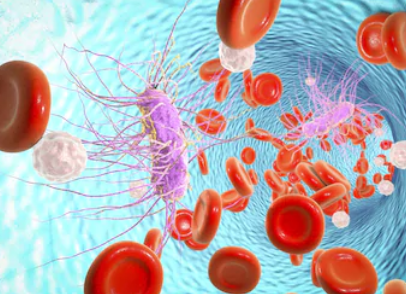 Sepsis is an acute systemic infection in which various pathogenic bacteria invade the blood circulation, grow and multiply in the blood, and produce toxins. Pathogenic bacteria are usually bacteria, fungi, and so on. The clinical manifestations are generally acute onset, chills, high fever, shortness of breath, tachycardia, rash, joint swelling and pain, hepatosplenomegaly, and changes in spirit. If the bacteria invading the bloodstream are cleared by the body's defenses, it is called bacteremia when there are no obvious symptoms of toxemia. When it is accompanied by multiple abscesses and a longer course is called sepsis. In severe cases, acute organ dysfunction may occur, known as severe sepsis. The elderly, children and people with weakened immune functions are susceptible groups.
Sepsis is an acute systemic infection in which various pathogenic bacteria invade the blood circulation, grow and multiply in the blood, and produce toxins. Pathogenic bacteria are usually bacteria, fungi, and so on. The clinical manifestations are generally acute onset, chills, high fever, shortness of breath, tachycardia, rash, joint swelling and pain, hepatosplenomegaly, and changes in spirit. If the bacteria invading the bloodstream are cleared by the body's defenses, it is called bacteremia when there are no obvious symptoms of toxemia. When it is accompanied by multiple abscesses and a longer course is called sepsis. In severe cases, acute organ dysfunction may occur, known as severe sepsis. The elderly, children and people with weakened immune functions are susceptible groups.
Diagnosis of Sepsis
The diagnostic methods for sepsis are:
- Blood test. When suffering from sepsis, there is leukocytosis, immature leukocytes are more than 10%, and thrombocytopenia with diffuse intravascular coagulation.
- Etiological examination. Take blood, body fluids (such as pus, hydrothorax, ascites, cerebrospinal fluid, etc.) or bone marrow for culture in order to examine the pathogen.
- Serum procalcitonin (PTC) examination. PCT is a marker of bacterial infection and sepsis, during which PCT levels are elevated. This examination is of reference value for the early diagnosis of sepsis, and also helps to evaluate the efficacy of antibacterial drugs in patients with sepsis and shorten the course of treatment.
- Heparin-binding protein (HBP) examination. HBP shows resistance activity at the site of infection. When sepsis occurs, HBP levels increase.
- Imaging diagnosis. If the infection site is not obvious, imaging diagnosis can be performed, including X-ray examination, CT, ultrasound, MRI, etc.
- Other examinations. In addition to the above examinations, organ dysfunction examinations, tissue perfusion examinations, and blood non-specific examinations and others should also be performed.
Advantages of Our Products
Creative Biogene's sepsis diagnostic products mainly use analysis modes such as fluorescence immunoassay, immunoturbidimetry, enzyme immunoassay and molecular assay, to detect PTC, HBP and other substances in serum. Moreover, our products also include a series of sepsis-related proteins and antibodies to meet your diagnosis and research needs in all aspects.
Creative Biogene is an expert in the field of sepsis diagnosis. More discounts, more surprises, we look forward to your selection! We will provide you with our optimal products.
Please contact us for more details.
Reference
- Wacker C, et al. (2013). "Procalcitonin as a diagnostic marker for sepsis: a systematic review and meta-analysis." The Lancet infectious diseases. 13.5: 426-435.
- Linder A, et al. (2009). "Heparin-binding protein: an early marker of circulatory failure in sepsis." Clinical infectious diseases. 49.7: 1044-1050.
For research use only. Not for any other purpose.
 Sepsis is an acute systemic infection in which various pathogenic bacteria invade the blood circulation, grow and multiply in the blood, and produce toxins. Pathogenic bacteria are usually bacteria, fungi, and so on. The clinical manifestations are generally acute onset, chills, high fever, shortness of breath, tachycardia, rash, joint swelling and pain, hepatosplenomegaly, and changes in spirit. If the bacteria invading the bloodstream are cleared by the body's defenses, it is called bacteremia when there are no obvious symptoms of toxemia. When it is accompanied by multiple abscesses and a longer course is called sepsis. In severe cases, acute organ dysfunction may occur, known as severe sepsis. The elderly, children and people with weakened immune functions are susceptible groups.
Sepsis is an acute systemic infection in which various pathogenic bacteria invade the blood circulation, grow and multiply in the blood, and produce toxins. Pathogenic bacteria are usually bacteria, fungi, and so on. The clinical manifestations are generally acute onset, chills, high fever, shortness of breath, tachycardia, rash, joint swelling and pain, hepatosplenomegaly, and changes in spirit. If the bacteria invading the bloodstream are cleared by the body's defenses, it is called bacteremia when there are no obvious symptoms of toxemia. When it is accompanied by multiple abscesses and a longer course is called sepsis. In severe cases, acute organ dysfunction may occur, known as severe sepsis. The elderly, children and people with weakened immune functions are susceptible groups.